
Sciadopitys verticillata, the kōyamaki or Japanese umbrella-pine, is a unique conifer endemic to Japan. It is the sole living member of the family Sciadopityaceae and genus Sciadopitys, a living fossil with no close relatives. The oldest fossils of Sciadopitys are from the Late Cretaceous of Japan, and the genus was widespread in Laurasia during most of the Cenozoic, especially in Europe until the Pliocene.

Umbilicus rupestris, the navelwort, penny-pies or wall pennywort, is a fleshy, perennial, edible flowering plant in the stonecrop family Crassulaceae in the genus Umbilicus so named for its umbilicate (navel-like) leaves.

Ilex verticillata, the winterberry, is a species of holly native to eastern North America in the United States and southeast Canada, from Newfoundland west to Ontario and Minnesota, and south to Alabama.

Allocasuarina huegeliana, commonly known as rock sheoak is a species of flowering plant in the family Casuarinaceae and is endemic to Western Australia. It is a dioecious tree that has its leaves reduced to scales in whorls of eight to ten, the mature fruiting cones 14–35 mm (0.55–1.38 in) long containing winged seeds (samaras) 5–7 mm (0.20–0.28 in) long.

Pennywort is a common name given to several different plants around the world. In general they have round leaves and a low-growing habit. Pennywort may refer to:

Centella asiatica, commonly known as Indian pennywort and Asiatic pennywort, is a herbaceous, perennial plant in the flowering plant family Apiaceae. It is native to tropical regions of Africa, Asia, Australia, and islands in the western Pacific Ocean. It is consumed as a culinary vegetable and is used in traditional medicine.

Hydrocotyle umbellata is an aquatic plant that thrives in wet, sandy habitat. Its English common name is manyflower marshpennywort or dollarweed. It is native to North America and parts of South America. In Brazil it is known as acariçoba and has applications in herbal medicine with purported anxiolytic, analgesic and anti-inflammatory properties. It can also be found growing as an introduced species and sometimes a noxious weed on other continents. It is an edible weed that can be used in salads or as a pot herb.
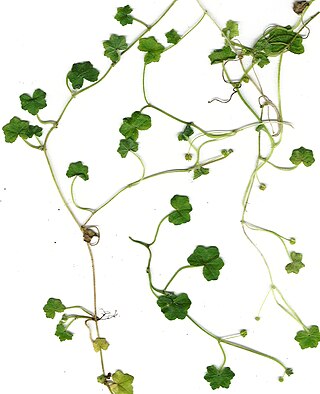
Hydrocotyle, also called floating pennywort, water pennywort, Indian pennywort, dollar weed, marsh penny, thick-leaved pennywort and even white rot is a genus of prostrate, perennial aquatic or semi-aquatic plants formerly classified in the family Apiaceae, now in the family Araliaceae.

Hydrocotyle ranunculoides, known commonly as floating pennywort, or floating marshpennywort, is an aquatic plant in the family Apiaceae. It is native to North and South America.

Asclepias verticillata, the whorled milkweed, eastern whorled milkweed, or horsetail milkweed, is a species of milkweed native to most of eastern North America and parts of western Canada and the United States.

Hydrocotyle vulgaris, the marsh pennywort, common pennywort, water naval, money plant, lucky plant or copper coin, is a small creeping aquatic perennial plant native to North Africa, Europe, the Caucasus and parts of the Levant.

Allocasuarina verticillata, commonly known as drooping she-oak or drooping sheoak, is a nitrogen fixing native tree of southeastern Australia.

Pilularia globulifera, or pillwort, is an unusual species of fern in the family Marsileaceae. It is native to western Europe, where it grows at the edges of lakes, ponds, ditches and marshes, on wet clay or clay-sand soil, sometimes in water up to 30 cm (12 in) deep.
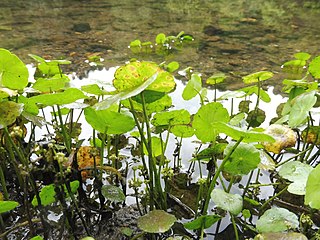
Hydrocotyle prolifera, commonly called whorled marshpennywort , is a species of flowering plant in the ginseng family (Araliaceae). It is native to North America and South America, where it is widespread. In the United States, it is largely restricted to the southeastern and southwestern regions. Its natural habitat is in swamp forests, or in pools of standing water.
Hydrocotyle hirta, commonly known as the hairy pennywort, is a species of flowering plant in the family Araliaceae native to Australia.
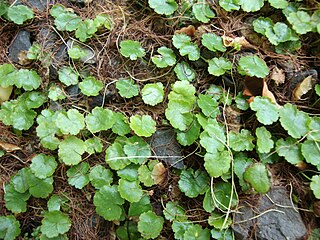
Hydrocotyle sibthorpioides is a small plant native to southeastern Asia. It is also referred to as lawn marshpennywort. It is a dicot, traditionally placed in the family Apiaceae, but more recently suggested to belong in the Araliaceae. It grows in abundance when the conditions are right. Hydrocotyle sibthorpioides originated in southeastern Asia, but is slowly spreading in the United States, along with other places around the world. It can grow in a wide variety of habitats. It has been used for medicinal purposes in Asia and is also common in the aquarium trade.

Hydrocotyle phoenix is a species of annual pennywort and is commonly called fire pennywort. It is only known to grow in south-west Australia, specifically in fire prone habitats; it is unique in this regard as it is the only species of Hydrocotyle known to have a fire adapted life-history. The specific epiphet "phoenix" references this fire adapted life history as in Greek mythology, a phoenix experiences rebirth by rising from ashes, much like how this plant rises from the ashes after a wildfire.
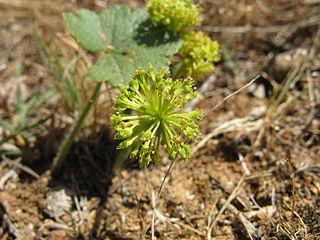
Hydrocotyle laxiflora is a species of plant in the family Araliaceae.
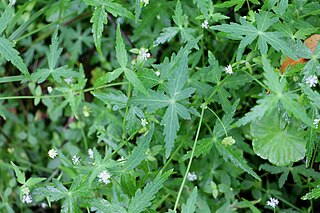
Hydrocotyle geraniifolia, commonly known as the forest pennywort, is a species of Hydrocotyle found in Australia. The habitat is moist forest floors often on the sides of hills.



















